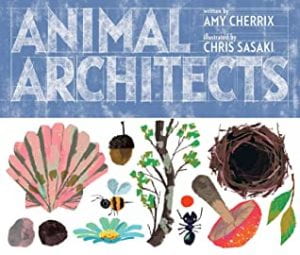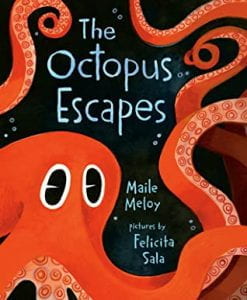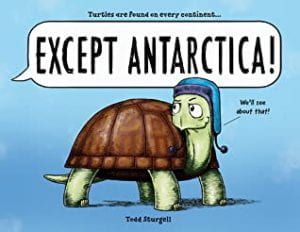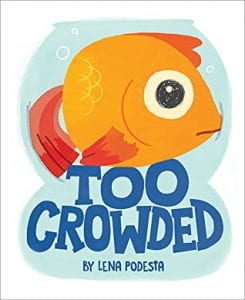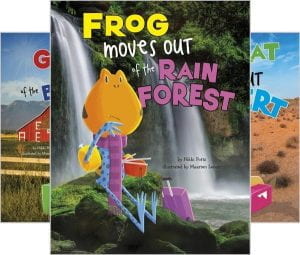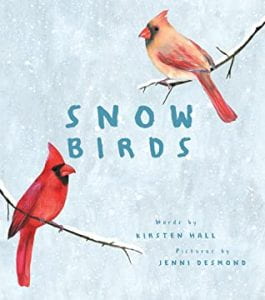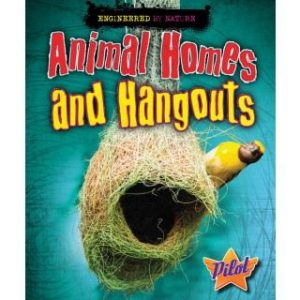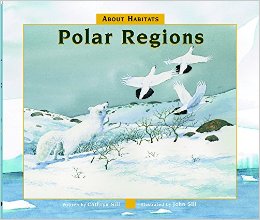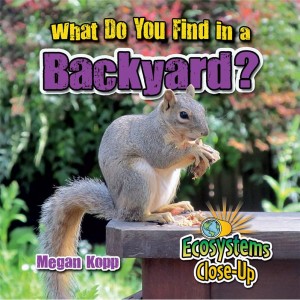
Kopp, Megan. Ecosystems Close-Up (series). New York: Crabtree, 2016. 24 p. $14.95 ea. Gr.K-3.
What Do You Find in a Backyard? 978-0-7787-2255-7.
What Do You Find in a Coral Reef? 978-0-7787-2257-1.
What Do You Find in a Pond? 978-0-7787-2259-5.
What Do You Find in a Rainforest Tree? 978-0-7787-2261-8.
What Do You Find in a Tide Pool? 978-0-7787-2265-5.
What Do You Find in a Saguaro Cactus? 978-0-7787-2263-2.
Learning about biomes, habitats and ecosystems feels more valuable to young learners when they can get up close and see the details. This series by Megan Kopp helps to explain and show the connections between life and land in various parts of the world. Each text has a similar pattern of contents, with many nonfiction features such as captions, models, thought bubbles, glossary and even extra activities. The photographs are still the best part since they show what words can only explain and make the reader appreciate the hidden treasures of nature. THOUGHTS: Great series to support primary units of science need to be relatable and consistent, and Kopp provides just that through her work. I would definitely lend these to teacher seeking nonfiction text features.
Science (Habitats) Dustin Brackbill, Mt. Nittany Elementary
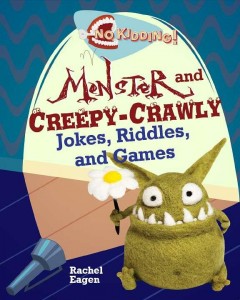
No Kidding (series). St. Catherines, Ontario: Crabtree, 2016. 32 pp. $20.75ea. Gr. 3-6.
Christopher, Clara. Animal: Jokes, Riddles, and Games. 978-0-7787-2387-5.
Eagan, Rachel. Monster and Creepy-Crawly: Jokes, Riddles, and Games. 978-0-7787-2389-9
Rodger, Anne-Marie. Sports: Jokes, Riddles, and Games. 978-0-7787-2390-5.
Rodger, Marguerite. Around the World in Jokes, Riddles, and Games. 978-0-7787-2388-2.
Colorful photographs and illustrations are found throughout the series. Each book has “funny bone” sections. The layout offers a table of contents, eight concise chapters, a glossary and index. Additional books are recommended and hall of fame biographies or spotlights are included for the respective topics. Some of the favorite jokes include “why the golfer wears two pants” and “what did the ocean say to another ocean”. The books offer activities such as making a comic strip baseball card and telling a joke. THOUGHTS: The series provides a link to add humor tied into language arts. Figurative language examples are included. This is a fun series that can draw many readers into many topics with laughter.
808.88; Language Arts Beth McGuire, Wendover Middle School
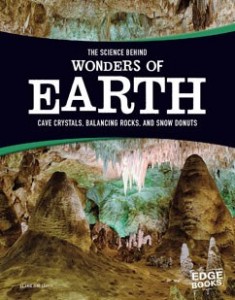
The Science Behind Natural Phenomena. North Mankato, MN: Capstone Press, 2017. $20.99 ea. $83.96 set of 4. 32 pp. Gr. 3-6.
Garbe, Suzanne. The Science Behind Wonders of the Sun: Sun Dogs, Lunar Eclipses, and Green Flash. 978-15157-07783.
Garbe, Suzanne. The Science Behind Wonders of the Water: Exploding Lakes, Ice Circles, and Brinicles. 978-15157-07769.
Leavitt, Amie Jane. The Science Behind Wonders of Earth: Cave Crystals, Balancing Rocks, and Snow Donuts. 978-1515707738.
Morey, Allan. The Science Behind Wonders of the Sky: Auroras, Moonbows, and St. Elmo’s Fire. 978-15157-07776.
Designed to answer upper elementary readers’ questions and pique their interest in natural phenomena, this series provides answers to rainbows, clouds, caves, the aurora borealis, comets, and sinkholes including how, where, when and why these phenomena occur. The Science Behind Wonders of Earth covers snow donuts, the sliding stones of Racetrack Playa (CA), caves, giant crystals, basalt columns and sinkholes. The Science Behind Wonders of the Sky covers auroras, moonbows, comets, meteoroids, cloud formations, St. Elmo’s Fire, and thunder and lightning. Each phenomena is accompanied by color photographs or illustrations that draw in readers. The information for each varies from a scant one page (St. Elmo’s Fire) to six pages (cloud formations). End matter includes glossary, index, further reading, three critical questions, and FactHound.com link for updated online resources. THOUGHTS: This is geared for upper elementary but can easily find a place in middle-high school as well. The topics are interesting enough to warrant further resources and research.
550; Natural Phenomena Melissa Scott, Shenango High School
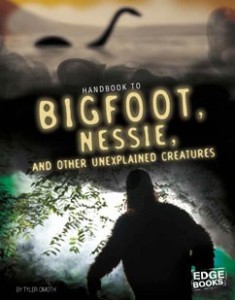
Paranormal Handbooks. North Mankato, MN: Capstone Press, 2017. $20.99 ea. $83.96 set of 4. 32 pp. Gr. 3-6.
McCollum, Sean. Handbook to UFOs, Crop Circles, and Alien Encounters. 978-15157-13098.
McCollum, Sean. Handbook to Ghosts, Poltergeists, and Haunted Houses. 978-15157-13081.
Omoth, Tyler. Handbook to Bigfoot, Nessie, and Other Unexplained Creatures. 978-15157-13111.
Omoth, Tyler. Handbook to Stonehenge, the Bermuda Triangle, and Other Mysterious Locations. 978-15157-13104.
This new series of four books from Capstone covers paranormal phenomena, drawing in readers with eerie covers and copious use of color and illustrations or photos. Ghosts, Poltergeists, and Haunted Houses covers each of these three topics, giving definitions and well-known examples of each. While the illustrations or stories may be creepy, McCollum carefully ends each section with clear comments that science has never proven any of the phenomena. Bigfoot, Nessie, and Other Unexplained Creatures leaves more questions about the existence of these creatures. For example, after speculation on mermaids, author Omoth concludes, “it’s worth keeping an eye on the water in case an authentic mermaid is lurking nearby” (16). Omoth reports on Bigfoot, Nessie, mermaids, chupacabra, the Jersey Devil, Mothman, Spring-Heeled Jack, and the Loveland Frogmen. These titles close with a quiz, glossary, index, further reading, and FactHound.com links. THOUGHTS: Readers of Bigfoot, Nessie, and Other Unexplained Creatures may be frustrated by the mixed messages from the author: basically that there is no proof, but the legend/stories continue, so look out! This tactic can make the reader feel like the author is joking. Ghosts provides an “answer” based on investigations: no evidence of ghosts, poltergeists or hauntings has ever been found. This is an additional selection only for collections whose titles on paranormal topics have aged.
001.942 Paranormal Phenomena Melissa Scott, Shenango High School
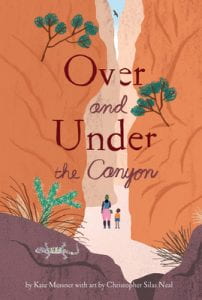 Messner, Kate. Over and Under the Canyon. Chronicle Books, 2021. 978-1-452-16939-2. 56 p. $18.99. Grades K-3.
Messner, Kate. Over and Under the Canyon. Chronicle Books, 2021. 978-1-452-16939-2. 56 p. $18.99. Grades K-3. 
